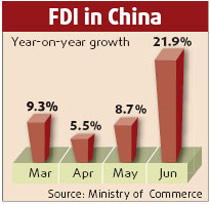The world economy will slow down in 2008, but strong growth in developing countries will offset weakened developed economies like the United States, a World Bank report said yesterday.
After a 3.9 percent world economic growth in 2006, the global economy slowed to 3.6 percent in 2007. That pace will ease to 3.3 percent this year, according to the World Bank report, Global Economic Prospects 2008.
Developing economies' resilience in 2007 has cushioned the global slowdown caused mainly by the US, the world's largest economy. Growth in developing economies was a strong 7.4 percent in 2007, the same as in 2006, the report said.
The bank forecasts real GDP growth for developing countries will ease to 7.1 percent in 2008, while high-income countries will grow by just 2.2 percent.
Countries in the East Asian and Pacific region achieved the fastest growth of an average 10 percent in 2007. China led the region at 11.3 percent.
"The pick-up in regional growth in 2007 was all the more notable because it occurred despite a slowdown in the US economy," said Hans Timmer, co-author of the report.
The global economy may face risks including a weaker US dollar, a US recession and rising financial market volatility in 2008, according to the report.
These risks would cut export revenue and capital inflows for developing countries and reduce the value of their dollar investments abroad, it said. As a result, the reserves and other buffers that developing countries have built up could decrease in real value.
"Overall, we expect developing country growth to moderate only somewhat over the next two years. However, a much sharper United States slowdown is a real risk that could weaken medium-term prospects in developing countries," said Uri Dadush, director of the World Bank's Development Prospects Group and International Trade Department.
The report expects credit turmoil to last until late 2008, but costs to large financial institutions to remain manageable. It said negative impact from the US housing market would be limited.
"As a result and given a cheaper US dollar, American exports are expanding rapidly. This is helping shrink the US current account deficit and is contributing to a decline in global imbalances," said Timmer.
Recent robust growth in developing countries has contributed to high commodity prices, notably for oil, metals and minerals. These have benefited commodity exporters, which explains strong demand in some poor countries, the report said.
But the recent increase in grain prices - partly due to greater production for biofuels - is hurting real incomes among the urban poor.
The theme of the report is technology in developing countries. It attributes real income growth in those nations to technological progress in the past 15 years.
Developing nations' fast technological progress has helped reduce the proportion of people living in absolute poverty from 29 percent in 1990 to 18 percent in 2004, it said. It is also expected to help reduce poverty worldwide in the next decade.
"Technological progress increased 40 to 60 percent faster in developing countries than in rich countries between the early 1990s and early 2000s," said Andrew Burns, lead economist and main author of the report.
(China Daily January 10, 2008)


